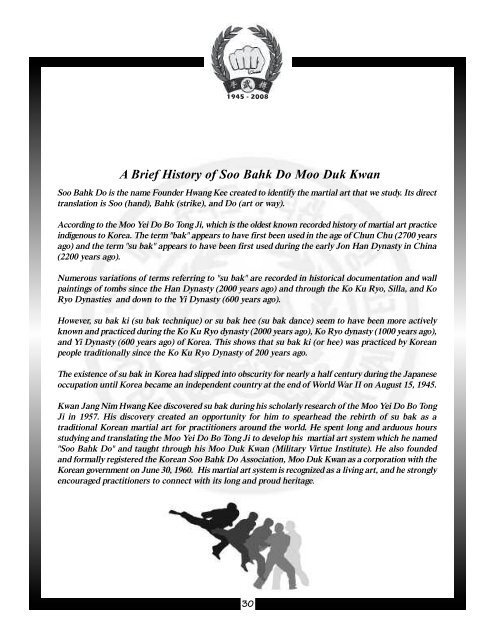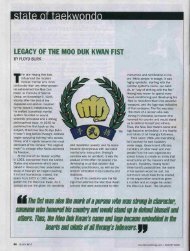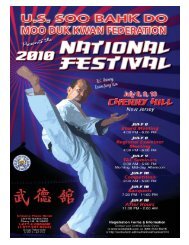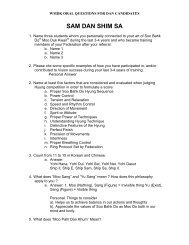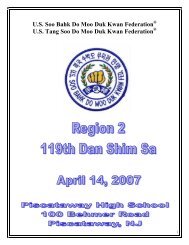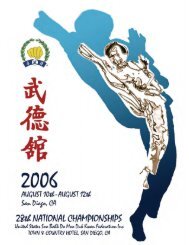2008 Nat Program - US Soo Bahk Do Moo Duk Kwan Federation Wiki
2008 Nat Program - US Soo Bahk Do Moo Duk Kwan Federation Wiki
2008 Nat Program - US Soo Bahk Do Moo Duk Kwan Federation Wiki
Create successful ePaper yourself
Turn your PDF publications into a flip-book with our unique Google optimized e-Paper software.
A Brief History of <strong>Soo</strong> <strong>Bahk</strong> <strong>Do</strong> <strong>Moo</strong> <strong>Duk</strong> <strong>Kwan</strong><br />
<strong>Soo</strong> <strong>Bahk</strong> <strong>Do</strong> is the name Founder Hwang Kee created to identify the martial art that we study. Its direct<br />
translation is <strong>Soo</strong> (hand), <strong>Bahk</strong> (strike), and <strong>Do</strong> (art or way).<br />
According to the <strong>Moo</strong> Yei <strong>Do</strong> Bo Tong Ji, which is the oldest known recorded history of martial art practice<br />
indigenous to Korea. The term "bak" appears to have first been used in the age of Chun Chu (2700 years<br />
ago) and the term "su bak" appears to have been first used during the early Jon Han Dynasty in China<br />
(2200 years ago).<br />
Numerous variations of terms referring to "su bak" are recorded in historical documentation and wall<br />
paintings of tombs since the Han Dynasty (2000 years ago) and through the Ko Ku Ryo, Silla, and Ko<br />
Ryo Dynasties and down to the Yi Dynasty (600 years ago).<br />
However, su bak ki (su bak technique) or su bak hee (su bak dance) seem to have been more actively<br />
known and practiced during the Ko Ku Ryo dynasty (2000 years ago), Ko Ryo dynasty (1000 years ago),<br />
and Yi Dynasty (600 years ago) of Korea. This shows that su bak ki (or hee) was practiced by Korean<br />
people traditionally since the Ko Ku Ryo Dynasty of 200 years ago.<br />
The existence of su bak in Korea had slipped into obscurity for nearly a half century during the Japanese<br />
occupation until Korea became an independent country at the end of World War II on August 15, 1945.<br />
<strong>Kwan</strong> Jang Nim Hwang Kee discovered su bak during his scholarly research of the <strong>Moo</strong> Yei <strong>Do</strong> Bo Tong<br />
Ji in 1957. His discovery created an opportunity for him to spearhead the rebirth of su bak as a<br />
traditional Korean martial art for practitioners around the world. He spent long and arduous hours<br />
studying and translating the <strong>Moo</strong> Yei <strong>Do</strong> Bo Tong Ji to develop his martial art system which he named<br />
"<strong>Soo</strong> <strong>Bahk</strong> <strong>Do</strong>" and taught through his <strong>Moo</strong> <strong>Duk</strong> <strong>Kwan</strong> (Military Virtue Institute). He also founded<br />
and formally registered the Korean <strong>Soo</strong> <strong>Bahk</strong> <strong>Do</strong> Association, <strong>Moo</strong> <strong>Duk</strong> <strong>Kwan</strong> as a corporation with the<br />
Korean government on June 30, 1960. His martial art system is recognized as a living art, and he strongly<br />
encouraged practitioners to connect with its long and proud heritage.<br />
30


